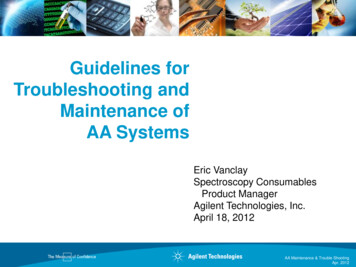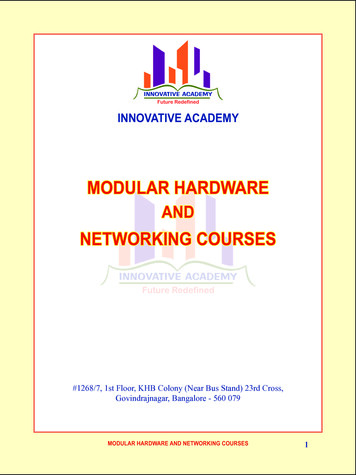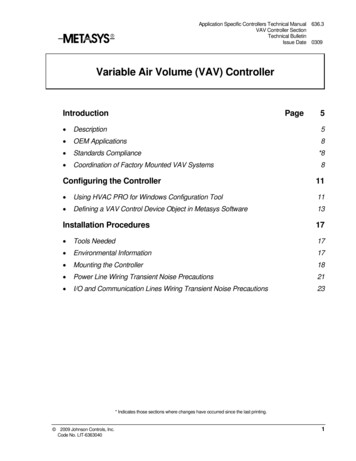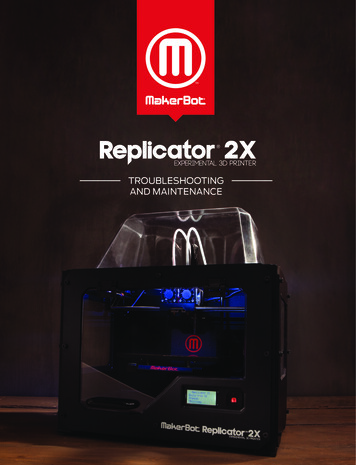
Transcription
Guidelines forTroubleshooting andMaintenance ofAA SystemsEric VanclaySpectroscopy ConsumablesProduct ManagerAgilent Technologies, Inc.April 18, 2012AA Maintenance & Trouble ShootingApr. 2012
Today’s Agilent: Atomic SpectroscopyWorld’s best, most complete atomic spectroscopy portfolio!ICP-MSICP-OESMP-AESGraphiteFurnace AASFlame AASAAS instruments can beflame only, furnace only, orcombined (switchable)2AA Maintenance & Trouble ShootingApr. 2012
Agilent’s Atomic Spectroscopy Portfolio - FeaturesFlame AAMP-AESLowest priceLowest runningcostTrace levels atlowest priceFastestmeasurementBroadest coverage Single element DLs typically 100’sppb Fast (for 1 element) Good elementalcoverage Low running cost Multi element DLs typically singleto 10’s ppb Faster Broader elementalcoverage Lowest running cost Single element DLs typically 10’s to100’s ppt Very slow Limited elementalcoverage Moderate running cost Multi element DLs typically singleppb Very fast Can measure mostelements High running cost Multi element DLs typically singleor sub-ppt Fast Can measure almostall elements Highest running costLowest3Furnace AASelling PriceICP-OESICP-MSHighestAA Maintenance & Trouble ShootingApr. 2012
Common AA Problems Reported by CustomersSensitivity: Sensitivity is worse than it used to be I have a new application and I can’t get the sensitivity I need How come I can’t get the instrument to meet published detection limits?Precision Sensitivity is acceptable but precision is terribleAccuracy Instrument does not give the “right” results.Poor Sample Throughput4 The instrument throughput needs to improve Burner blocks too quicklyAA Maintenance & Trouble ShootingApr. 2012
AA Sensitivity - What Impacts This?4 areas of the instrument can affect sensitivity:– Sample introduction system (and AA lamp optimization)– Method parameters– Cleanliness– Quality of standards used for calibrationRemember – SMCQOr“System Must Create Quality”5AA Maintenance & Trouble ShootingApr. 2012
Sensitivity – Quality of Standards– What concentration are they? Low concentration standards have a finite life– Prepare ppb (ug/L) concentration standards daily from high conc. stock– Prepare low ppm (mg/L) concentration standards weekly– How are they prepared? Ensure purchased standards are within “Use By” date Use calibrated pipettes and class ‘A’ volumetric flasks for dilutions Use de-ionized water (Type I - conductivity 18 M /cm3) – lower grades mayhave contamination– How are they stored? Plastic vessels ensure better stability Stabilize with acid – low pH ensures better stability6AA Maintenance & Trouble ShootingApr. 2012
AA Sensitivity – Sample IntroductionWhat to Check?– Lamp type and alignment Alignment should be checked –gain setting should be consistent Lamp type can improveperformance e.g. using highintensity UltrAA lampOptimum viewing height for Ca– Burner Burner position must be optimized(vertical, horizontal & rotationalpositioning) Burner type changes path length(for air/acetylene elements)7AA Maintenance & Trouble ShootingApr. 2012
AA Sensitivity CompromiseCaN20/C2H2Higher Sensitivity8Air/C2H2Lower NoiseAA Maintenance & Trouble ShootingApr. 2012
AA Sensitivity – Sample IntroductionWhat to Check?– Nebulizer settings Nebulizer uptake rate– low flow rates better for high%TDS samplesEffect of impact bead position forabsorbance signal with 5 ppm Cu– Impact bead position– Acetylene cylinder contentsremaining (acetone can “mask”any signal)9AA Maintenance & Trouble ShootingApr. 2012
AA Sensitivity – Method ParametersWhat to Check?– Gas flows Flame stoichiometry affects sensitivity (oxidizing vs reducing flame)– Wavelength/Slit selection and Lamp current Using the most sensitive line? Check you’re using the rec. lamp current and slit width (different for multielement lamps)– Interferences? Physical interferences can affect aerosol formation– Use matched standards or standard additions Chemical interferences can reduce atom formation– Use high temperature N2O/acetylene flame appropriate matrix modifiers10AA Maintenance & Trouble ShootingApr. 2012
Nitrous Oxide/Acetylene Flame StoichiometryLean11StoichiometricRichAA Maintenance & Trouble ShootingApr. 2012
AA Sensitivity – System CleanlinessWhat to Check?– Clean windows? Check lamp and sample compartment windows Smudges or chemical residue reduces light throughputand increases noise– Sample Introduction System Deposits in nebulizer can reduce sample uptake rate Solid material on burner slot reduces path length and increases noise Contamination in spray chamber impacts on aerosol formation – increasesnoise12AA Maintenance & Trouble ShootingApr. 2012
AA Sensitivity – Rec. SettingsFor most flame AA applications: Fit the mixing paddles Optimize the impact bead for best sensitivity Use narrow bore capillary tubingFor highest flame AA sensitivity: Remove mixing paddles Adjust impact bead further away from the nebulizer Use wide bore capillary tubing (highest uptake rate)For high TDS samples: Fit the mixing paddles Adjust impact bead ½ to 1 turn clockwise (towards nebulizer) from optimum sensitivityposition Use wide bore capillary tubing (to reduce chance of blockage)13AA Maintenance & Trouble ShootingApr. 2012
Agilent Flame AA Performance – BenefitsFlexibility, Ease of Use & Superior Flame PerformanceTunable performance means Highest flame sensitivity: 0.9 Abs. for 5 mg/L Cu Best precision: 0.5 % RSDusing 10 x 5 s readings Extended operation withdifficult samples No loose gas hoses andno tools required for gasconnection Fast change-over to furnaceoperation (manual - 30 s)14AA Maintenance & Trouble ShootingApr. 2012
GFAA Sensitivity – Sample IntroductionWhat to Check?– Lamp type and alignment Alignment should be checked – gain setting should be consistent Lamp type can improve performance e.g. using high intensity UltrAA lamp– Furnace workhead Workhead position must be optimized (want light beam to pass through centreof graphite tube)– Align lamp first (no workhead), then place workhead in position and alignLight Beam AlignedThrough Center ofGraphite Tube15AA Maintenance & Trouble ShootingApr. 2012
GFAA Sensitivity – Sample IntroductionWhat to Check?– Sample Dispenser settings Carefully adjust injection depth – easy with the furnace camera– Autosampler rinse Acidify rinse with 0.01 % (v/v) HNO3 plus a few drops of Triton X-100– Choice of inert gas impacts sensitivity Argon gas preferred – ensures optimum sensitivity and best tube life Nitrogen gas reduces sensitivity by up to 20 % and decreases tube life16AA Maintenance & Trouble ShootingApr. 2012
GFAA Sensitivity – Correct Capillary AlignmentCorrect dispensing Pipet tip too high! Capillary tip must remain in contact withsolution during dispensing– Reduce dispensing height if samplespreads due to low surface tension Ensure there is no liquid on the outsideof the capillary after dispensing Ensure there is no liquid inside thecapillary tip after dispensing Sample should remain as a drop in thecentre of the tubePipet tip too low! 17AA Maintenance & Trouble ShootingApr. 2012
GFAA Sensitivity – Method ParametersWhat to Check?– Furnace parameters Set appropriate drying temperature and time (2-3 sec/uL of solution injected) Optimize ashing temperature using ashing study – use SRM optimization Ensure inner gas flow “off” just prior to atomizationDoes the sample sizzle orsplatter during the dry stage? Listen for the sound Use the mirror or furnacevideo to monitor thesample drying18AA Maintenance & Trouble ShootingApr. 2012
Automated Furnace Method Optimization SRM “Wizard” automates furnaceoptimization Optimizes absorbance as a function ofashing and atomization temperature Automatically creates a method usingrecommended conditions Reduces training requirements for newusersOptimizationresults for Pbdeterminationusing phosphatemodifier19AA Maintenance & Trouble ShootingApr. 2012
GFAA Sensitivity – Method ParametersWhat to Check?– Wavelength/Slit selection and Lampcurrent Using the most sensitive line? Check you’re using the rec. lamp current andslit width (different for multi-element lamps)– Interferences? Physical interferences can affect samplespreading in the tube– Maintain constant volume; use matchedstandards and partitioned tube Chemical interferences can reduce atomformation– Use modifiers with temp. programming,matrix match & standard additions20AA Maintenance & Trouble ShootingApr. 2012
GFAA Sensitivity – CleanlinessWhat to Check?– Clean windows? Check lamp and sample compartment windows Smudges or chemical residue reduces light throughput and increases noise– Sample Introduction System Deposits on capillary tip can affect sample dispensing Ensure no bubbles in dispensing syringe (current design is bubble free) Residues in graphite tube impacts on sensitivity – may cause contamination,high noise or high background– Condition tube before use (even if starting with a new tube)– Helps to “bed” the tube in21AA Maintenance & Trouble ShootingApr. 2012
Agilent Furnace AA Performance – BenefitsFlexibility & Superior Furnace PerformanceCompetitor Highest furnace sensitivity Best correction capability: 2 % error at 2 Abs. b’ground High speed correction Best capability to handledifficult samplesAgilent More sensitivityLower noise22AA Maintenance & Trouble ShootingApr. 2012
Hydride AA Sensitivity – Sample IntroductionWhat to Check?– Sample and reductant pump rates Check the pressure bar - only apply enough pressure to ensure uniform flow Check pumping rates– Quartz cell positioning Quartz cell position must be optimized (want light beam to pass through centreof the cell)– Align lamp first (no cell), then place the cell into position and alignLight Beam AlignedThrough Center ofQuartz Cell23AA Maintenance & Trouble ShootingApr. 2012
Hydride AA Sensitivity – Sample IntroductionWhat to Check?– Was the cell conditioned beforeuse? If required, recondition the cell again– Allow longer pre-read delay time(Hg needs a longer time)– Use an acid rinse betweensolutions– Check acid tubing for deterioration– Check/clean absorption cell24AA Maintenance & Trouble ShootingApr. 2012
Hydride AA Sensitivity – Sample Introduction Low Signal with As:– Check AsIII stable – not being oxidized back to AsV Low Signal with Se:– Ensure KI not added before analysis Low Signal with Hg:– Check that Hg is stabilized in solution– Avoid presence of KI – clean system thoroughly with 1% sodiumthiosulfate (or swap reagent modules)25AA Maintenance & Trouble ShootingApr. 2012
Agilent Hydride AA Performance – Benefits Faster than graphite furnace technique– 50 – 70 analyses per hour– Relative easy to automate Analyte is removed from matrix– Eliminating matrix interferences– Minimizing background– Can easily analyze matrices that are difficult to run by graphite furnace 100 % sampling efficiency– Detection limits in the sub-ppb range– Extremely sensitive for ultra-trace Hg Excellent in run precision– Typically 1 – 2 % RSD26AA Maintenance & Trouble ShootingApr. 2012
Precision - Why is This Important?What does “Precision” mean?– Ability to get the same result for the samesample when measured multiple times– Usually measured as % RSD or sometimes, SD% RSD (SD / Mean Result) * 100– Low values indicate good precision For flame AA, expect 1% RSD (Hydride AA 2% RSD) For GFAAS, expect 4% RSDWhy is this important?– User loses confidence in the systemWhat impacts on precision?– Lamp and burner/plasma stability– Sample introduction system– Method parameters27AA Maintenance & Trouble ShootingApr. 2012
AA Precision – What to Check?– Lamp properly aligned?– System stabilized? Allow 5-10 mins. warm-up for lamp/burner before analysis– Sample Introduction Nebulizer uptake rate adjusted– High uptake rate means great sensitivity and worse precision Impact bead adjusted correctly Burner position optimized? Mixing paddles fitted? Measuring at an appropriate concentration– Close to the detection limit, noise is high and precision/accuracy is impacted28AA Maintenance & Trouble ShootingApr. 2012
Accuracy - Why is This Important?What does “Accuracy” mean?– Ability to get the “right” answer for the sample– Heavily dependent on operator’s skillWhy is this important?– User loses confidence in the system– Your reputation Customer’s question the results Poor performance in “round robin” comparisonsHow do You Confirm Accuracy?– Check the result for a prepared standard– Measure a certified reference material– Use other quality control checks to check analysis29AA Maintenance & Trouble ShootingApr. 2012
Accuracy – What to Check?– Calibration standards properly prepared? See earlier recommendations – important to match to samples, prepareaccurately and use them “fresh”– Any interferences impacting on results?– Use matched standards or standard additions– For AA - use high temperature N2O/acetylene flame appropriate matrixmodifiers– Precision optimized Optimum signal to noise performance improves accuracy Measuring at an appropriate concentration– Close to the detection limit, noise is high and precision/accuracy is impacted30AA Maintenance & Trouble ShootingApr. 2012
Sample Throughput – What to Check?– Samples fully digested? No excess particulates in the sample that may cause blockage– Sample Introduction System optimized?– Capable of handling the TDS levels in the sample– Burner cleaned and ready for analysis?– Method parameters optimized Pre-read delay time is appropriate – optimized Read time is appropriate for the expected concentration– Use a longer measurement time at low concentrations Rinse time is appropriate Use a faster measurement technique – like Fast Sequential AA31AA Maintenance & Trouble ShootingApr. 2012
Flame AA – Recommended Maintenance ScheduleDaily: Empty waste container Check exhaust system Clean burner compartment & instrument Check the gas delivery pressures & cylinder contents (esp. acetylene) Check the nebulizer uptake rate and burner conditionWeekly: Clean burner (or earlier if required) Disassemble flame atomization system and clean– Check condition of O rings and impact bead (no pitting)Monthly: Clean windows in sample compartment32AA Maintenance & Trouble ShootingApr. 2012
Furnace AA – Rec. Maintenance ScheduleDaily: Empty waste container Check exhaust system Check condition of the graphite tube – replace as necessary– When replacing the tube, check the condition of the electrodes Clean the workhead around the sample injection hole Check dispensing capillary “free” and syringe Top up rinse reservoir as required Check the gas delivery pressures & cylinder contentsWeekly: Check and clean furnace workhead windows (if required)33AA Maintenance & Trouble ShootingApr. 2012
Hydride AA – Rec. Maintenance ScheduleDaily: Empty waste container Check pump tubing for stretching, deformation or severe discoloration– Release after each analysis Check connections to the reaction coil Clean the absorption cell (soak in nitric acid) Clean any spills and wipe the pump unitWeekly: Replace and condition the absorption cell (or earlier as required) Check the rollers rotate freely34AA Maintenance & Trouble ShootingApr. 2012
Overview - Key Consumables for AAAll instruments:– HC lamps– AA standard solutionsFlame AA systems:– Glass impact beads, burner cleaning strips, nebulizer components,capillary tubing, burners etc– Ionization suppresant / buffer solutions– With the SIPS dilution system – SIPS pump tubing and transfer tubing– With an autosampler - sample tubes, racks, probes and transfer tubingGraphite furnace AA systems:– Graphite tubes– Sample vials, dispensing capillary and syringe for autosampler– Matrix modifiersVapor generation AA systems:– Quartz atomization cells– Peristaltic pump tubing– Connecting tubing35AA Maintenance & Trouble ShootingApr. 2012
Flame Atomizer - Mark 7 DesignKey consumable items requiring frequent replacement: O ringsGlass impact beadsBurner cleaning stripsNebulizer capillary kitNebulizer venturi kitCapillary tubingNebulizer cleaning wireLiquid trap assyMixing paddlesBurnersWhere to find ordering details? 36On-line help in the SpectrAA S/WAgilent website – dedicated webpage: Mark 7 SparesAgilent Quick Reference Guide for AAAgilent Atomic Spectroscopy Supplies CatalogueAA Maintenance & Trouble ShootingApr. 2012
Where to Find the Right Consumable?Analytical Consumables:Consumables & SuppliesAgilent Assist:Instrument Sales &Services1-800-227-9770 (Option 1,1)www.agilent.com/chem/contactus1-800-227-9770 (Option 1,3)www.agilent.com/chem/contactusOn-Line resources:Atomic Absorption SuppliesMark 7 Sample Introduction SparesICP-OES Parts & Supplies PortfolioICP-MS SuppliesInstrument Parts & SuppliesFAQsAtomic Spec. Application NotesAgilent Quick Reference Guide for AA (pub. # 5990-9476EN)Agilent Atomic Spec. Supplies Catalogue (pub. # 5990-8767EN)Agilent Consumables Catalogue (pub. # 5990-6674EN)Instrument User Manuals37AA Maintenance & Trouble ShootingApr. 2012
Summary – To Achieve Quality Data Most “instrument” failures occur in the sample introduction area– Includes BurnerSpray chamberNebulizerAll tubingDrain Assembly Improper maintenance of this area can result in poor data quality Frequently less experienced analysts can fail to recognize problems resulting inproductivity losses Establishing maintenance procedures can prevent problems38AA Maintenance & Trouble ShootingApr. 2012
Questions?Agilent MP-AESAgilent AASAgilent ICP-OESAgilent ICP-MSThe Market Leaders in Atomic Spectroscopy39AA Maintenance & Trouble ShootingApr. 2012
AA Sensitivity - Rec. Settings For most flame AA applications: Fit the mixing paddles Optimize the impact bead for best sensitivity Use narrow bore capillary tubing For highest flame AA sensitivity: Remove mixing paddles Adjust impact bead further away from the nebulizer Use wide bore capillary tubing (highest uptake rate)











